Pete’s Gear: The Marshall ‘Stack’
Pete Townshend and John Entwistle and the development of the Marshall ‘Stack’ and 100-watt amplifier
Marshall releases 40th anniversary Marshall stack JTM45/100
See Pete’s signature page or Marshallamps.com for more info.
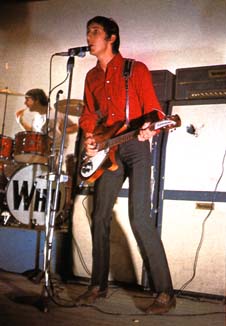
9 September 1966, with Two Marshall JTM45 100 Tremolo (1959T JTM100 Tremolo Super Lead) heads and two Marshall 8×12 cabinets. Note the Y-cable splitting the guitar signal to both amps. Guitar is Rickenbacker Rose, Morris Co., LTD, 1997.
Though someone would’ve likely “invented” it sooner or later, John Entwistle and Pete Townshend are responsible for the development of the de rigueur rock guitar amplifier setup known as the “stack” and the 100-watt amplifier.
John’s and Pete’s desire (and escalation) to have the loudest gear was the impetus for Marshall to build the first 100-watt amplifiers. Jim Marshall, owner of J&T Marshall Musical Instruments, LTD, a music shop in Uxbridge Road, Hanwell, West London, and whose engineers, Ken Bran and Dudley Craven, had begun building amplifiers for sale in their shop in September 1962, notably the infamous JTM45 45-watt head (soon upped to 50 watts, as the model 1987) and the JTM45 combo (later the model 1962; made popular as the “Bluesbreaker” by Eric Clapton). Pete and John, as well as many other musicians of the time, were frequent customers of Marshall, urging him in the “latest” direction of the burgeoning West London music scene. The JTM45 was modeled after the ‘ideal’ sound of the Fender Bassman, a 50-watt amplifier. According to Marshall, Pete, among others, bought one of the first of these amps. However, for John’s and Pete’s needs, that wasn’t loud enough to “drown” out the audience (or play louder than the likes of Keith Moon). Many amp manufacturers’ collective fear was that 100 watts would be impossible because of component meltdown. There was no such thing as a 100-watt output transformer — so instead they would end up pairing two 50-watt transformers.
Ken Bran’s first attempt in 1965 was a four 6V6 output valve configuration; the second used four 6L6 valves; and the third had four KT66 output valves. Success.
Pete and John bought the first four, at £160 each.
Update – 2015
New details from Ronnie Wood’s diary published in 2015 calls into question the sequence of events long held in Marshall and Who history. An excerpt from a Guitar Player review of the book:
“...Me and Pete Townshend had a different sort of rivalry back then to see who could get the loudest. We kept on pushing Jim Marshall to make amps with more watts and volume controls that went up to 12!”
Marshall enthusiasts and historians will be surprised to see Wood’s entry for September 24, 1965, where he mentions getting a 100-watt head and 8×12 speaker cabinet from the Marshall shop (“a knockout sound,” he proclaimed). Previously it was thought that Marshall made only six 8×12 cabinets — two for Pete Townshend, two for John Entwistle, and two display models that the Small Faces eventually bought. Wood states in his recent footnote that he suggested the idea of a cabinet with eight speakers to Jim Marshall, and “Pete Townshend came in and went, ‘You bastard!’” The fact that the Who were first seen with their 8×12 cabinets on November 13, 1965 and Wood took delivery of his custom cabinet in September gives his claim that he was the person who conceived the 8×12 considerable legitimacy.
“Jim’s shop was great,” says Wood. “We’d go there all the time to get our guitars and amps fixed or buy new gear. Marshall would build custom amps to your specifications. Terry Slater who worked there used to do us favors and help us out with easy payments. He had a weak spot for me. He’d say, ‘It’s okay, Ronnie. You can take it away and try it out. Just pay me as soon as you can.’ All I needed to do was get permission from my parents as guarantors since I was under 18...”
The “stack”
The stack derived from both a desire to project sound better and a desire to have an intimidating backline. In 1964, John first connected his Marshall JTM45 to, first one, then two side-by-side Celestion G12-loaded Marshall 4×12s. Pete followed this up by placing his Marshall 4×12 on a waist-high metal stand, thus generating considerable feedback to the guitar’s pickups. Next, possibly due to the small stages at the time, as well as to create an imposing visual force, Pete stacked one cabinet atop another, driven by his ’64 blonde Fender Bassman 50w head (gold sparkle grille, white round knobs), and thus the “stack” was born. The bottom cabinet was likely a dummy.
In mid-1965, John and Pete would switch to Vox gear, Pete with two Vox AC-100 100-watt amplifiers and cabinets (and John with two Vox T-60 amplifiers and cabinets; See Max The Mod’s great description (offline)). Unsatisfied with the sound (and following their van being stolen on 2 September; after which they leased Vox gear until November, when they unceremoniously dumped it back at the hire company), however, they returned to Marshall for their continuing quest for volume and power.
Pete urged Marshall to develop an actual “stack,” an 8×12 cabinet. Delivered in November 1965 (first known use is 13 Nov., 1965, at La Locomotive Club, Paris, France), the 8×12s would pair up with the 100w amplifiers to create an imposing backline. The 8×12s featured an angled top portion and a straight profile for the remaining six speakers. These cabinets actually had an open back to the top portion, closed on the bottom. For the most part, these cabinets had all the features of today’s “stack,” but proved unwieldy with their weight and size. Marshall only made six of these 8×12s, four going to The Who and two to the Small Faces. Two weeks later, Pete returned to Jim Marshall asking for the stacks to be cut in half. Although Marshall indicates they couldn’t be divided because of butt joints, as seen in photos, at least some of the cabinets were cut in half to increase portability — as well as make knocking the top cabinet over easier during the destruction finale.
In late 1965, production versions of this “stack” followed in the Marshall 1960A (angled-front top 4×12 cabinet) and 1960B (base; flat-front 4×12 cabinet), the instantly recognizable Marshall “stack” of today.
Through 1966–67, Both Pete and John varied their setups, either in traditional stack form, with the amp on top of the cabinets, two amps stacked high, one on top of the other, on top of cabinets, or as a precursor to their future rigs, with the amps on a stand or chair next to the speaker cabinets. Pete early on ran the guitar to a split “Y” cable to power both amplifiers. Later, he used “daisy chain” cabling, where the guitar lead went into the “High Treble” input of channel I amp and out of channel II into the second amp. John would also use a split cable, or occasionally had dual/stereo jacks on his Jazz bass, with each lead going into one amp, one for treble frequencies (treble dimed, bass rolled off), one for bass frequencies (vice versa).
Pete and John used these pre-production 100-watt amplifiers and the 8×12s, as well as other Marshall amps, such as the production JTM100s and beginning late 1966, model 1967 Marshall Major Lead (affectionately called the “Pig”) 200w amps, and 1982 and 1960 Marshall 4×12 cabinets, into 1967.
Unfortunately, for U.S. shows in 1967, Pete and John used Vox U.S. Thomas Organ Super Beatle solid-state amps, as they couldn’t afford to bring their own gear. So while the Who were renowned in England for the sheer power and volume of their Marshall gear, it was Hendrix (and The Cream) who would ultimately gain notoriety in the USA for “pioneering” the Marshall backline.
In early 1967, John would transition to Sound City L100 amplifiers and cabinets, and soon after, in mid 1967, Pete would follow suit, using two Sound City L100 100-watt heads and four Sound City 4×12 in two stacks, a precursor to his most famous setup, two Hiwatt CP103 100-watt heads and four Hiwatt SE4123 4×12 in two stacks.
Selected quotes from Pete Townshend, John Entwistle and Jim Marshall
All quotes and references are copyright their original owners and are included for reference only.
Guitar World, June 1994
During this period circa 1964, many key elements of the Who’s approach to the guitar fell into place. It was John Entwistle who first bought one of the new 4×12, closed-back speaker cabinets that London music store owner Jim Marshall had begun to manufacture. The Marshall cabinet gave John such a boost in volume that Pete was compelled to get one as well. And from there, it was just a short step to Townshend’s pioneering use of feedback. It was at the Oldfield Hotel, where the band had first discovered Keith Moon, that Townshend made an equally momentous discovery.
“Where I stood on the stage was a piano, and I stuck my cabinet on it and it was dead level with the guitar,” he explained to [Richard] Barnes. “And I started to get these feedback effects that I really liked. When I went to other gigs and put the speakers on the floor, it wouldn’t happen. So I started to put it up on a chair and then I decided to stack the things so that I could induce feedback.”
Thus was born the Marshall stack.
Guitar, December 1973
When I first got amplified with big speakers, I used to have them at waist level. I could never work out why most people played with them on the floor. I wanted them belting in my ear-hole. So I used to put mine on a great stand so the speak was actually firing into the guitar pick-up dead level. Feedback started by accident and I started to use it. Simple as that. The more I used it, the better I got.
From Before I Get Old
At the Oldfield, Townshend sometimes placed his amp on an unused piano at the back of the stage. When he switched to Rickenbacker guitars in late 1963, he began placing the amp at the same height as the guitar’s single-coil pickup, causing electroacoustic feedback.
“The Yardbirds, funnily enough, were the reason I hit upon it,” Townshend told Paul Nelson in 1968. “When I was at school, I lived with this guy who used to go and see Eric Clapton. And he would come back saying, ‘Look, you’ve got to do this! Eric Clapton does this great thing where he goes ba-ba-ba-bam on the guitar for hours and hours and everyone goes crazy and lights flash on and off and it’s great, it’s great.’ So I used to go ba-ba-ba-bam and attempt to do this from what I’d heard from him. Luckily enough, the influence, which could have been very obvious and direct if I’d actually gone to see Clapton was very effective coming secondhand.
“I used to play at this place where I put my amp on the piano, so the speaker was right opposite my guitar. One day, I was hitting this note and I was going ba-ba-bam and the amplifier was going u-ur-ur-ur on its own. I said to myself, ‘That’s fun. I’ll fool around with that.’ And I started to pretend I was an airplane. Everyone went completely crazy.
“I started to use it, I started to control it. I regulated the guitar so that the middle pickup was preamped on the inside with a battery and raised right onto the strings so that it would feed back as soon as I switched it on. And I could control it and go through all kinds of things.”
Entwistle and Townshend soon after started stacking their amplifiers, with their huge four-by-twelve speaker cabinets. (Townshend at first used to place his amp on a chair to locate the feedback.) “An electric guitar is really a guitar and a microphone,” said Roger. “Pete used the microphone part instead of the fretboard. He wasn’t interested in the technical qualities — he’d use it in a completely different way than [Jeff] Beck or [Jimi] Hendrix. He’d just bang it.”
From April 1980 issue of Sound International article, courtesy Joe G’s site.
“Jim Marshall started manufacturing amplifiers and somebody in his store came up with the idea of building a 4 × 12 cabinet for bass. And John Entwistle bought one and I looked at it and suddenly John Entwistle doubled in volume. And so I bought one and then later on I bought another one and I stacked it on top of the other one. I was using a Rickenbacker at the time and because the pickup was right in line with the speakers I was instantly troubled by feedback. But I really used to like to hear the sound in my ears.”
- You obviously like them [Hiwatts] more than Marshalls.
PT: I’ve never used Marshalls really. I tried Marshalls for a while because we always had a very friendly relationship with that firm but I never really used them. Everybody else did — Eric, Jimmy Page and Jeff, and Jimi Hendrix when he came over used Marshalls. I never got on with them, I don’t know why.
Guitar, August 1996
If I can say something about my life as a guitarist, it’s that I’m very proud of my contribution to the way it’s changed technically. I have the honor of still knowing Jim Marshall and his son Terry very well, and we still get together and go over what really happened in the early days with the design of the first really big amplifier. They credit me almost entirely — along with a couple of other people, a couple of bass players — with being the guy that drove them to produce the four-valve power amp. Fender didn’t go any further with it after the late ’50s, because the theory was if you went any further, literally all the other components would melt because they’d been designed for much lower voltages. The guy who played bass in Tripp Bennett & The Rebel Rousers — I can’t remember his name — and John Entwistle both wanted a slightly louder bass, they wanted that Fender Bassman [5F6A] sound but slightly louder. So they started with speaker design, driven by clones of the Fender amp. And then I went in and said to Marshall, “You know, it’s great now that John is louder, but now John is as loud as Keith Moon, and I’m still out on the stage fighting to be heard. I want to be louder, but I want my sound,” which was at that time a Fender Pro amp, with I believe a 15″ speaker, and a tweed Fender Bassman [combo], which was another 15″ speaker cabinet. The two were linked together with a split cable. I said I wanted that sound, exactly that sound, but just a bit louder, a bit bigger. They managed to achieve that. And then I went back and said, “No, I want it even louder, even bigger. What’s happening is very, very interesting.” There were harmonics happening that were very interesting. And I got very angry, very frustrated — I kept pushing them. I said, “You’d better fucking do this, there’s some thing happening here which is really interesting.” The guitar kind of starts to sound like a symphony orchestra. You get up to a certain pitch, and something happens between the pickup and the amp. Remember, I’d been experimenting with beats, and listening and listening, hearing all these kind of huge, cascading harmonics. I knew that in distortion there was music of a much higher harmonic order than anything that I could play, so I started that whole trip off.
Guitar World, 1997
Because, as I said, I was in this mode where the guitar was a weapon. And, wonderful though my Fender Pro amp sounded, it wasn’t loud enough. So I went out and bought a Fender Bassman as well and plugged into both. And, wonderful though that was, it wasn’t loud enough either. So I went to Jim Marshall’s [then a music store in London], threw down my Fender Bassman and said, “I want that, twice as loud.” And, almost like Krups, the military manufacturer, Jim Marshall’s eyes sort of lit up and he said, “I will supply this man with the weapon he requires.” And from that came the Marshall stack and the big amplifiers of the Sixties.
Vintage Guitar interview with Jim Marshall, October 1997
- When did the first Marshall stack appear?
I think that came about in ’65, when Townshend said he needed 100-watt heads. We made the first three 100-watt heads for him. I asked him what sort of cabinet he wanted, and he said he wanted eight 12s in one cabinet. I said that a big square cabinet with a little amplifier on top would look ridiculous, so I told him to let me design something. I built what turned out to be an 8 X 12 stack. Pete tried to carry it out of the workshop and it was so heavy. I told him his roadies were going to kill him, but he said, ‘They get paid.’ Two weeks later he came back and told me I was right, and he asked if I could cut it in half. I told him to leave it to me, and that I would redesign something that would do the job. I went back to the straight 100 4 X 12, which is now the bottom cabinet, and put the angled one on top, and the amplifier on top of that. The stack was born.
- So would you say that it was Pete Townshend’s request for an 8 X 12 cabinet that inspired the design of the Marshall stack?
Yes, he’s the one who inspired it. But actually, some lads have even gone so far to say that Pete was responsible for the design.
- Did both Townshend and Hendrix require a lot of maintenance to their amps?
Pete never broke any one of his amps or the speakers, just the speaker cloth. He used to tear those with his guitars. That was it, and we used to replace them. Jimi Hendrix never smashed anything, really. He just tore the speaker cloth. But Jimi was away from England a lot and rarely got his speaker cloth replaced.
Jim Marshall: The Father of Loud, 2004
By 1965, the members of the Who were in an all-out volume war. Entwistle was setting a pair of Marshall 4×12 cabinets side by side in order to be heard above Keith Moon’s drumming. Jim had already bumped up the JTM45 to 50 watts (in the form of model 1987) and sold the head to Townshend, but the guitarist claimed he still couldn’t be heard over his own rhythm section. He loved the tone — Townshend heard what Jim had in the overdriven tubes — but he wanted more of it.
”We’d not even thought about making a 100-watt amp until Pete came into my shop and said he wanted us to make him some.” Jim states. “So I told him we’d have a go at making one. We made a prototype first then we made three heads just for him. We were so proud of them when they were finished. They were sitting on a bench in the workshop with us thinking they looked wonderful, and then Pete’s roadie came along and just threw them into the bloody truck! I remember thinking, ‘Oh, my God! I can’t believe he just did that.’”
“...When Pete started breaking the guitar, his dad and I thought, ‘The kid has gone stark raving mad.’ But Pete brought the first two Rickenbackers into me and he said, ‘Can you do anything with these? The idea is, I want them to appear to be the ones I’m using.’ What he used to do was, he’d be playing and then at the right time he’d quickly switch to one of the guitars I’d repaired; I had glued it together so it looked to be perfectly normal. And he’d break it again. He was not as stupid as everyone said! When he used to push the guitar through the speaker cabinet, he only used to tear the front baffling cloth. He never used to go through a speaker — we only had to repair the cloth.”
On Pete’s switch to Hiwatt
“It was unfortunate, but simply a misunderstanding. The group used to come in my shop, and at one time we were waiting for a check. The check was put in, but my son sent them another bill, thinking they still had a balance due. Pete said they had paid, but Terry swore, ‘No, you haven’t paid, you haven’t paid.’ So Pete was upset and went to Hiwatt. And Hiwatt was one of the first copies of us! It was a complete misunderstanding.”
Guitar World, September 2002, excerpt from ‘History of Marshall Amps’
…Marshall was soon persuaded to expand his line of merchandise to include other musical instruments, including electric guitars and amplifiers. Among the persuasive youngsters was a guitarist named Pete Townshend. In a few years he would find fame with the Who, but in 1960 Jim Marshall just knew him as the son of Cliff Townshend, the noted British sax player with whom he had played in several big bands.
Marshall recalls that young Pete voiced a complaint common among his youthful peers. “Pete said, ‘In the music shops in the West End of London, they treat us like idiots because we play rock and roll. So why don’t you sell amplifiers and guitars in your shop?’ I said, ‘Well, I know a lot about drums, but not guitars and amps. But I’ll have a go at this.’ I did, and it was successful right from the word ‘go.’”
…On the live front, however, no group did more to popularize Marshall amps during those early days than the Who. Marshall gear played an integral role in the explosive stage act the band was developing in the London clubs, before audiences of buzzed mod kids. The group’s ambition was to be the loudest, most aggressive rock and anyone had ever heard. Guitarist Pete Townshend and bassist John Entwistle began piling up speaker cabinets onstage like to rival nations amassing nuclear warheads.
“I bought some of the first Marshall cabinets ever made,” Entwistle recalls. “I bought one and Pete bought one. I bought another one, and Pete bought another one. And I said, ‘Well, is it loud enough? Fuck, I’ll buy two more.’”
By this point the JTM45 had morphed into the model 1987, and Marshall had switched from KT66 power tubes to EL34s, bring the power rating up to 50 watts. “The KT66s were quite successful but not easily obtainable,” says Marshall. “And that is why we went on to the EL34, which turned out to be the better valve. As a matter of fact, a lot of top players who had the 66s came back to us afterward and said, ‘Please use the 34. It’s got the better sound that we want.’”
But Pete Townshend wanted even more. In 1965 he approached Marshall with the idea of building a 100-watt amp.
“I went to Jim Marshall, stomped down my 50-watt amp and said, ‘I want that twice as loud,’” Townshend says. “And, almost like Krupps, the famous military manufacturer, Jim Marshall’s eyes lit up. He said, ‘I will supply this man with the weapon he requires.’ And out of that came the Marshall stack and the big amplifiers of the Sixties.”
Jim Marshall’s recollection of this pivotal moment in rock guitar history is more down-to-earth. “With that much power, we had to watch out for overheating,” he says. “But with careful planning we got over that.”
Townshend’s idea was to mate this new 100-watt Marshall head — dubbed model 1959 — with one huge 8×12 speaker enclosure. Jim Marshall had a quite a task convincing him that this design was hardly practical. “Originally Pete wanted a great big square 8×12 cabinet. I said, “That’s going to look absolutely stupid; the amplifier will look very small sitting on top of a cabinet like that. Leave it to me, Pete, what you want is the straight front cabinet I originally designed with the angled cabinet on top.’ He said, ‘No, I want it all in one cabinet.’ So we made these big, tall 8×12 cabinets. A chap who worked for me at that time was a muscle man, and I was quite strong too in those days. But the two of us had a hell of a job carrying these cabinets out of the workshop to put in Pete’s van. I said to Pete, ‘The roadies are going to complain like mad about these things, you know.’ He said, ‘They get paid.’ But within a week or two he came back to me and said, ‘You’re absolutely right. I tried to life one of these things with the roadies. It’s almost impossible, isn’t it?’ Then he wanted me just to cut his 8×12s in half. But we couldn’t do that, because in those days the cabinets were not tongue jointed [i.e., built with tight, interlocking wood joints]; they were butt jointed [i.e., with boards joined end to end] with hot glue. If you cut them in half, they would have fallen apart. So I said, ‘Leave it to me, Pete. I’ll sort this out the way I want, and you’ll be happy.’ So we went with the two 4×12s. He was happy. And that’s how the stack was born: for Pete.”
Guitar Player, October 1989
- It’s often been reported that you were the first guy to use Marshall stacks. Is that accurate?
Well, not really. John was the first person to use a Marshall stack on its side. He used two 4×12 cabinets, and I bought a single 4×12 and used it on a waist-high stand so my Rickenbacker would feed back. Then it seemed a logical extension to stand a top 4×12 on another 4×12 that was actually a dummy, and then eventually to do what John was doing and have two amplifiers. I never, ever used a stack with one amplifier until I got into Hiwatts, and I didn’t use Marshalls very long. In fact, I never used Marshall in the beginning at all. I used to use Fenders; I had a Fender Pro and a Fender Vibrasonic and a Fender Bassman top, and I used to drive Marshall 4×12’s with those amplifiers. I thought Marshalls were awful, and I’m afraid I still do, although that’s just a personal opinion. I don’t mean it’s bad stuff: I just mean I didn’t like the sound. And when I heard Hiwatt I was over the moon, because they sounded to me much more like a really good, top-line mid-’60s Fender amp. I still think it’s hard to beat Fender amps; they’re astonishing.
Guitar World, September 2000
In the old days I used to storm into Jim Marshall’s shop and swear at him. They’d run to build something new, and I’d come back the next day to saw that it wasn’t loud enough, or it wasn’t good enough. In the end I got what I wanted. And in so doing, what Jim Marshall did — and consequently the guy who built Hiwatt — was provide English heavy metal and blues players of the mid ’60s and early ’70s with these weapons.
Guitarist, August 1994
“Before John, Keith and I got into personal volume competitions, one of the first reasons I went to Jim Marshall to say ‘build me a big Marshall amp’ was because I wanted to shut the f***ing audience up. I was sick of standing playing in the Oldfield Hotel only to get Reggie Kray types in suits coming up during numbers to say [adopts Hale & Pace ‘The Management’ voice], It’s my girlfriend’s birthday — play the Tennessee Waltz. I’d try to put them off; We don’t actually know it... then he’d say, Play the f***ing Tennessee Waltz otherwise it’s the starting handle for you. So we’d be going ‘I was waltzing/With my darling/To the Tennessee Waltz’, looking at one another thinking, F*** this, as Reggie Kray or whoever waltzes round with his girl, sticks his thumb up to us, Well done, fellas. We had to do something. Johnny McLaughlin [yes, that one] had sold me my first Fender amp — a Pro — when he worked at Selmers, and it was a really great buy. I eventually took the Fender Pro and a Bassman head to Jim Marshall and said, I want this sound but I want it 10 times louder. When he asked why, I said, Because I don’t want to hear any heckling, I don’t want to hear any requests. All we want to hear when we’re in a hall is The Who — that’s all. We’re there so that they can hear themselves. We’re not there to hear them. Jim Marshall was amazingly inspired; I realise now that Jim was an angry young man too, though a few years older than me. But he was like the crooks’ weapon builder; like Uzi or Kalashnikov, and the enemy was the previous generation. He built a big, powerful amp, but I kept going back and saying, Bigger, bigger, and Jim would turn to his backroom bloke and say, Bigger; Pete wants it bigger, and so the amps would come back with yet another couple of big valves in the back.
Guitar Center, June 2002 interview with John Entwistle
I went through a whole collection of different 50-watt amps and different speakers until, contrary to popular belief, Marshall made the first 4 × 12″ speaker cabinets. I bought the second, fifth, eighth and ninth. We insisted to Marshall that we needed a 100-watt amplifier for more power. They insisted it was impossible, but made one anyway. Pete and myself bought the first four.
Guitar Player, November 1975, interview with John Entwistle
- What type of amplifier and guitar were you using when the Who first formed?
When we first started calling ourselves the Who I used a Marshall 50 watt amp with a 4-12 cabinet. I had the first 4-12 cabinet that Marshall made. We more or less forced them to make 100 watt amps by changing to Vox, who already had one out. Marshall decided that if they were going to keep us, they’d have to make a 100 watt amp. They used to make their amps with speaker material on the front, and they looked completely different. I said, “I don’t like that; I want it all black,” so they changed them. I bought another 4-12 cabinet, and then Pete bought another 4-12 cabinet, and it went on and on and on. We had more equipment than any band in the country — it was ridiculous.
From October 1994, Guitar World interview with John Entwistle
- GW: You introduced the first Marshall 4×12 cabinet into the Who.
Entwistle: Yeah, but I didn’t buy the very first one. It was a guy in a band called the Flintstones who got that. I bought the second one...and the fourth, and the seventh, and the eighth. Pete bought the ones in between. It was great. I’d buy one, he’d buy one, I’d buy one, then he’d buy another. And I went, “is it loud enough? Fuck, I’ll buy two more.” And I started using the two-amp system — bi-amping. Then we had a period where we switched to Vox equipment because we figured it would be louder. But it wasn’t. It just blew up. So we’d always been trying to convince Marshall to make us a 100-watt amp. They told us it would be impossible: the amp would be too heavy to carry around. We said, “Put a handle on each end.”
Excerpt from The Soul of Tone: Celebrating 60 Years of Fender Amps interview with Alan Rogan
“Pete has used Fender amps off and on for 40 years. [Re: the My Generation album:] I said, ‘Oh, Pete, it sounds fantastic,’ and he told me exactly what he used on it: two Rickenbackers — a 6-string and a 12-string — and a blonde Bassman head with a Marshall 4×12 cab. That was the sound on that album, from 1965.”
Photo Gallery
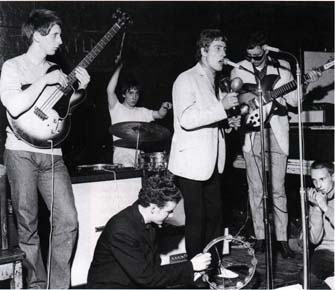
22 July 1964, Scene Club, John with early Marshall JTM45 and early Marshall 4×12, and Pete with custom ’64 Fender Pro “head” connected to one early Marshall 4×12 on table. Guitar is 1964 Rickenbacker Rose, Morris, Co., Ltd, 1998.
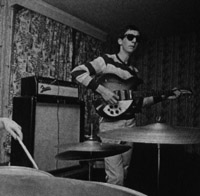
Click to view larger version. Ca. August/September 1964, at the Railway Hotel, Fender Pro head on top of early Marshall 4×12. Guitar is Rose Morris, Co. LTD., Rickenbacker1998 fitted with trapeze tailpiece from Gibson EDS-175.
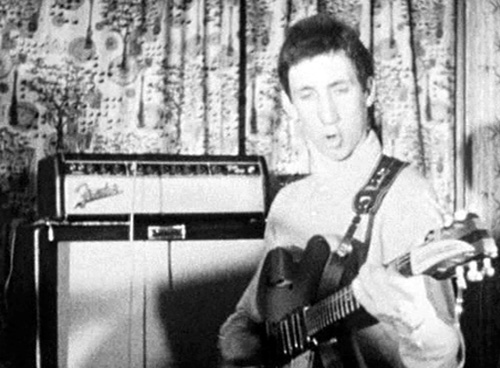
Ca. August/September 1964, at the Railway Hotel, with custom ’64 Fender Pro “head” (likely a Pro chassis inserted in a Bandmaster or Showman cabinet, by Jim Marshall) connected to one early Marshall 4×12 on stand. Guitar is 1964 Rickenbacker Rose, Morris, Co., Ltd, 1998.
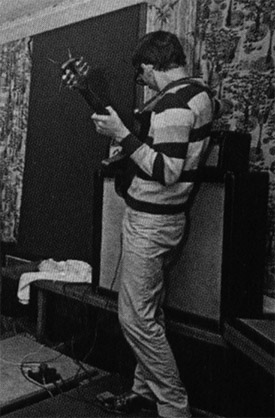
Ca. August/September 1964, at the Railway Hotel, Fender Pro head on top of early Marshall 4×12.
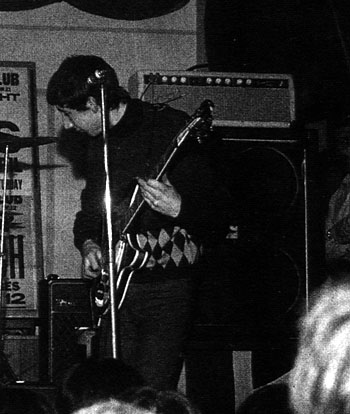
Ca. April 1965, at the Goldhawk, a precursor to the actual “Marshall” stack, a blonde ’62 or ’63 Fender Tremolux head stacked on two Marshall 4×12 cabinets, one with British flag “grillecloth” and one with grillecloth completely removed. Guitar is 1964 Rickenbacker 360/12 Export.
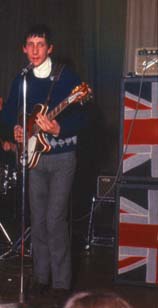
Precursor to the actual “Marshall” stack, Pete stacks a blonde ’64 Fender Bassman head on two Marshall 4×12 cabinets with British flag “grillecloths” in late 1965. Guitar is 1964 Rickenbacker 360/12 Export.
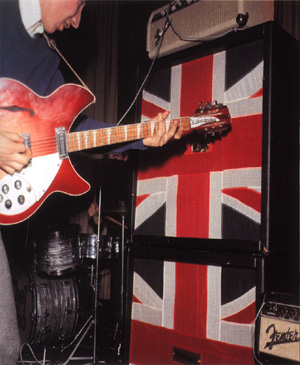
Click to view larger version. Ca. 1965, grinding a 1964 Rickenbacker 360/12 Export into an early “stack” of Marshall 4×12 cabinets powered by a Fender Bassman atop the stack, which is daisy-chained to a custom Fender Pro head at lower right.
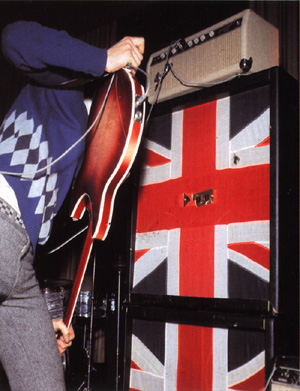
Click to view larger version. Ca. 1965, feeding back a 1964 Rickenbacker 360/12 Export through an early “stack” of Marshall 4×12 cabinets powered by a Fender Bassman atop the stack, which is daisy-chained to a custom Fender Pro head at lower right.
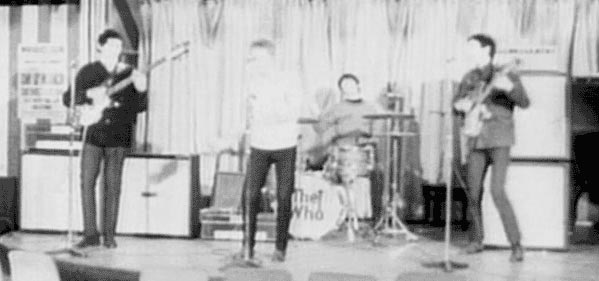
Ca. March 1965, at the Marquee. Precursors to the actual “Marshall” stack, John sits two Marshall 4×12s side-by-side, powered by a Marshall JTM45, and Pete stacks a blonde ’64 Fender Bassman head on two Marshall 4×12 cabinets.
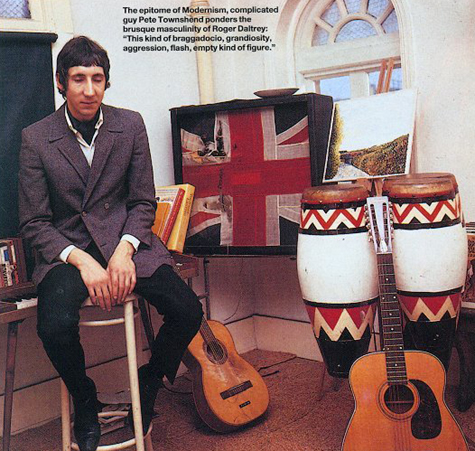
Wardour Street home studio, ca. 1966 or 1967, with early Marshall 4×12 on stand and Union Jack as grille cloth. Guitar at right is Harmony Sovereign H1270 12-string.
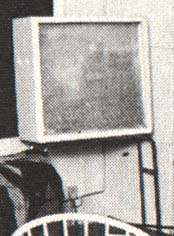
Early white-covered (or stripped) Marshall 4×12 straight-front cabinet on a stand in Pete’s home studio.
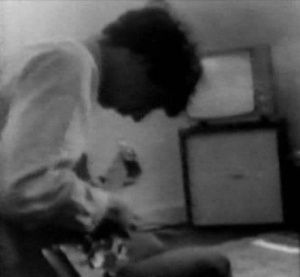
Ca. 1965 or 1966, early Marshall 4×12 slant-front cabinet (as TV stand) in Pete’s flat. (Pete is playing a Fender Bass VI baritone guitar.)
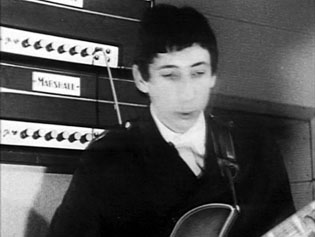
Ca. January 1965, with two like-new block logo JTM45 50-watt amplifier heads, in a stack setup. Guitar is 1964 Rickenbacker 360/12 Export.
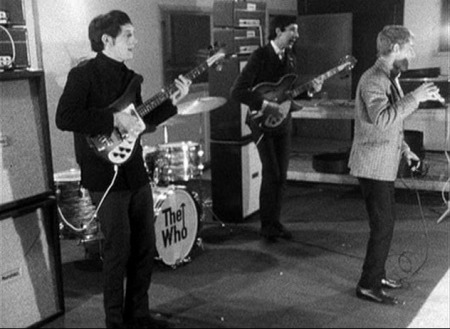
Ca. January 1965, John’s and Pete’s new Marshall 4×12 stacks, each powered by a pair of Marshall JTM45 50-watt amps. Guitar is 1964 Rickenbacker 360/12 Export.
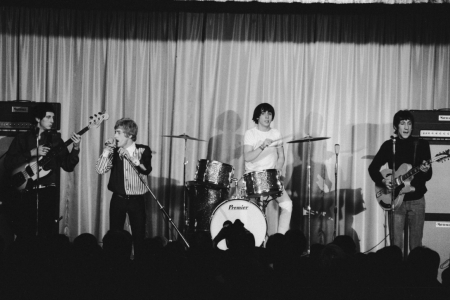
13 Nov. 1965, at La Locomotive Club, Paris, the first known photographed use of the new Marshall 8×12 cabinets. Pete appears to be playing through two Marshall JTM45 100 Tremolo (prototype 1959T JTM100 Super Lead) 100-watt amplifiers driving two Marshall 8×12 cabinets; John is using two 1959 JTM100 Super Lead 100-watt amplifiers driving two Marshall 8×12 cabinets. Pete’s guitar is also the first known use of the Grimshaw.
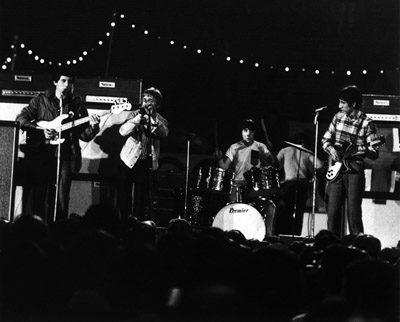
19 Nov. 1965, at the Glad Rag Ball, Wembley. Pete appears to be both playing through a (likely two) Marshall JTM45 100 Tremolo (prototype 1959T JTM100 Super Lead; John is using 1959 JTM100 Super Lead) 100-watt amplifier driving a Marshall 8×12 cabinet adorned with the Union Jack. Pete’ guitar is 1965 Rickenbacker Rose, Morris, Co., LTD, 1993. (Marshall 1969 PA 4×12 cab visible at far left.)
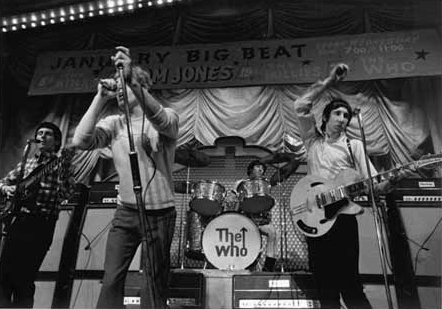
26 Jan. 1966, Locarno Ballroom, Stevenage, with John and Pete both playing through two Marshall JTM45 100 Tremolo (prototype 1959T JTM100 Super Lead; John is using 1959 JTM100 Super Lead) 100-watt amplifiers, connected by Y-cable, and driving two Marshall 8×12 cabinets. Guitar is a semi-hollow Grimshaw. (Two Marshall 1968 Super P.A. P.A. heads visible in front of drum riser.)
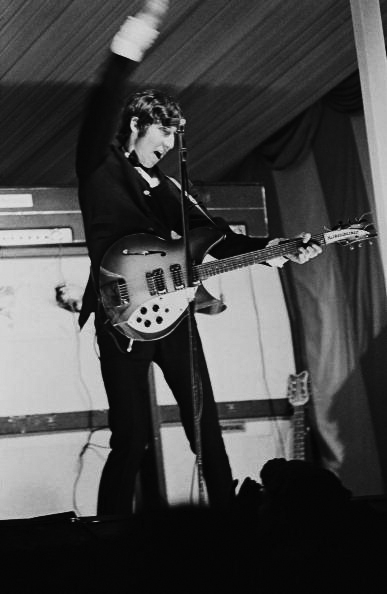
In July 1966, 6th National Jazz and Blues Festival, Windsor, two Marshall 8×12 cabinets, with original “THE WHO” shield badges still intact (see inset), appearing on cabinet crossbar as well as on the top left corner of the two Marshall JTM45 100 Tremolo (1959T JTM100 Tremolo Super Lead) amplifier heads (block logo).
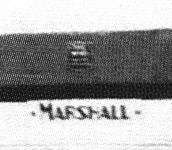
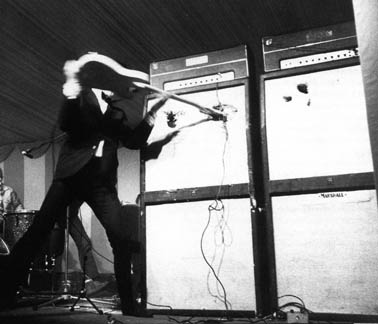
In July 1966, 6th National Jazz and Blues Festival, Windsor, two Marshall 8×12 cabinets (being impaled by a Fender Telecaster fitted with a non-Fender rosewood neck), with original “THE WHO” shield badges still intact (see inset), appearing on cabinet crossbar as well as on the top left corner of the two Marshall JTM45 100 Tremolo (1959T JTM100 Tremolo Super Lead) amplifier heads (block logo). Effects pedal is likely the Sola Sound Tone Bender MkI fuzz pedal.
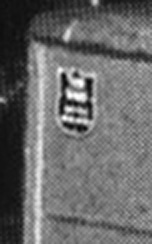
Closeup detail of “The Who” shield badge from Marshall Super P.A.
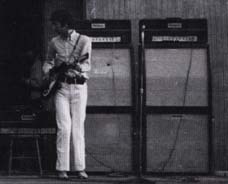
In June 1966, two Marshall JTM45 100 Tremolo (1959T JTM100 Tremolo Super Lead) heads (one block logo, one script logo) and two Marshall 8×12 cabinets (one script logo, one block logo — likely added later following a re-grille by Marshall’s). Note the Y-cable splitting the guitar signal to both amps. (Marshall JTM45 100 Super PA for vocals sits to the left of Pete’s rig.)
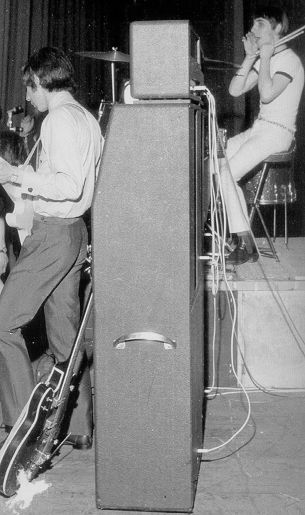
Ca. 1966, Side view of the Marshall 8×12 cabinet, with top portion open-back design visible. Note large cab handles. Guitars are Fender Telecaster (being played) and a Gretsch (Nashville?).
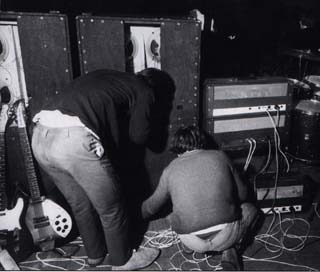
23 Oct. 1966, Malmo, Sweden, Rear view of the Marshall 8×12 cabinets, with top portion open-back design. The amplifiers are ’65 1959T JTM100 Super Lead Tremolo (top), ’67 1967 Marshall Major Lead (“Pig”), and on the ground, a Marshall JTM45 100 Super PA for vocals. Guitars are Fender Telecaster, left, and Rickenbacker 1997.
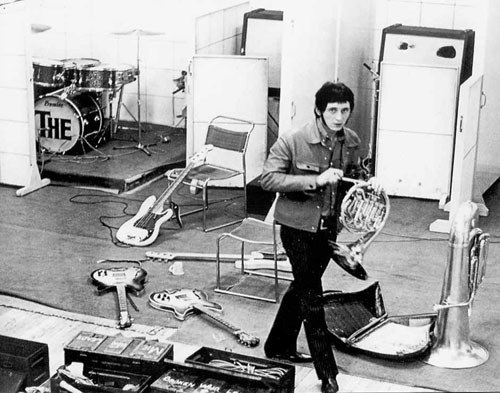
3 Oct. 1966, in CBS studios, John holding French horn. Leaning against the chair, the 1962 Fender Precision Bass, left, and on the floor, the 1966 “Slab” Fender Precision Bass. Guitars are two Rickenbacker Rose, Morris Co. LTD, guitars, a 1998 and 1993. In background, two Marshall 8×12 cabinets for the guitar and bass.
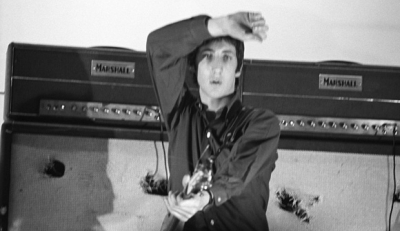
9 September 1966, with Two Marshall JTM45 100 Tremolo (1959T JTM100 Tremolo Super Lead) heads, connected by Y-cable splitting the guitar signal to both amps, and two Marshall 8×12 cabinets.
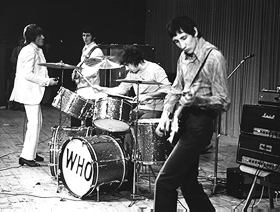
In 1966, Germany, with one script nameplate ’66 Marshall 1959 JTM100 Super Lead 100w head (top) and one ’65 JTM45 100 Tremolo 100w head with older style nameplate (bottom), topped with Grampian Reverb unit. Guitar is Fender Stratocaster. A Marshall JTM45 100 Super PA for vocals is visible on floor behind the drums.
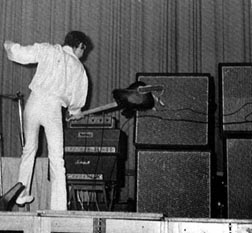
In 1967, with one ’65 Marshall JTM45 100 Super P.A. 100-watt head used as a guitar amp (top with block logo), one Marshall 1959 JTM100 Super Lead heads (bottom, with script logo), topped with Grampian reverb unit. Speakers are, on left, two Sound City 4×12 cabinets, and on right, Marshall 1982A, top, and Marshall 1982B, bottom. Guitar is Fender Telecaster.
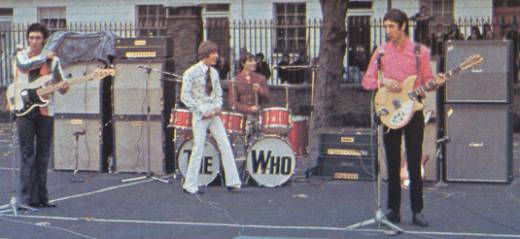
12 Nov. 1966, John Entwistle, with two Marshall JTM45 100 100w heads and two Marshall 8×12 cabinets; Pete with one Marshall JTM45 100 100w Tremolo head (top), one 1967 Marshall Major (“Pig”) 200w head (bottom) with one Marshall 8×12 cabinet, plus, to the right, Marshall 1982A angled 4×12 100w cab (top) and Marshall 1982B (extra tall) straight 4×12 100w cab. Pete’s guitar is 1965 or 1966 Rickenbacker 360/12 Mapleglo.
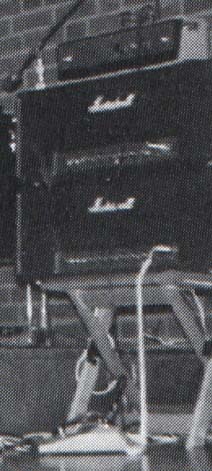
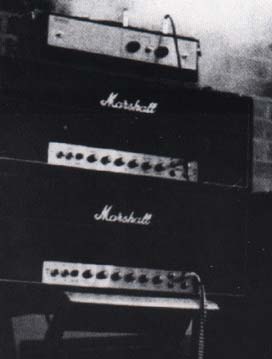
4 May 1967, Sweden, closeup of two ’66 Marshall 1959 JTM100 Super Lead 100w amplifier heads, with Grampian Reverb unit (top) and Marshall Supa Fuzz fuzz pedal (floor).
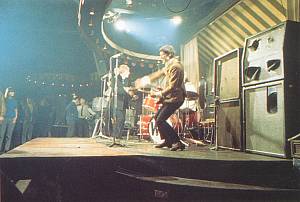
At the Marquee Club, Wardour Street, on 2 March 1967, with what’s left of the 1982A and 1982B cabinets (right), as well as two standard-sized 1982B cabinets (left). Amps are ’66 Marshall 1959 JTM100 Super Lead 100w amps. Guitar is a Fender Stratocaster.
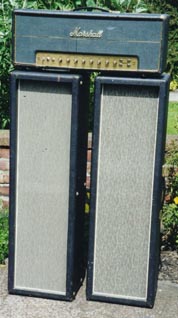
Pete Townshend’s Marshall Super 100 amplifier, courtesy Rock Stars Guitars. Rock Stars Guitars: These were later used by Jimi Hendrix for his guitar setup until he had amps of his own. Kit Lambert supplied many Marshall amps and speakers which were previously used by The Who to The Experience in the early days. Later on they were then given to Tappy Wright who was part of the Hendrix management team.
’66 Marshall JTM45 100 watt Super Trem Mark IV amplifier
Click an image to view full version. Courtesy Tom Niforatos: Details of an early ’66 Marshall JTM45 100 watt Super Trem Mark IV amplifier (1959T JTM100 Tremolo Super Lead). One of likely 12 made. Dual 50w output transformers. Still has its original KT66 valves.
Resources and Information
For more information:
- Rock Stars Guitars: rockstarsguitars.com
- Max The Mod: westminsterinc.com/who1965/equip.htm (offline)
- Dr. Tube Guitar Amp Schematics: drtube.com/marshall.htm
- PlexiPalace Vintage Amps Forum: vintageamps.com/plexiboard/viewforum.php?f=1 (archived)
- Jim Marshall: The Father of Loud
Manufacturer:
- Marshall Amplification: marshallamps.com





